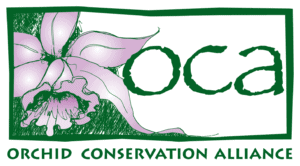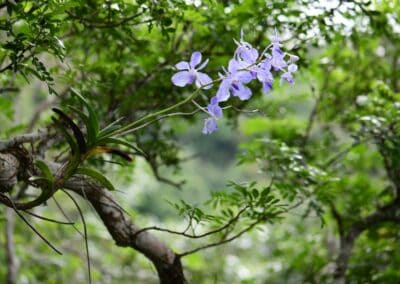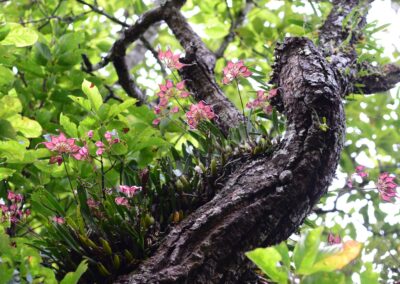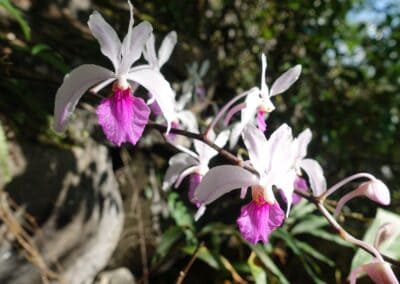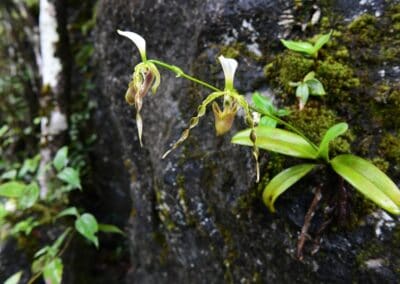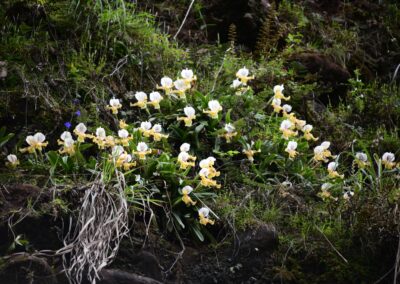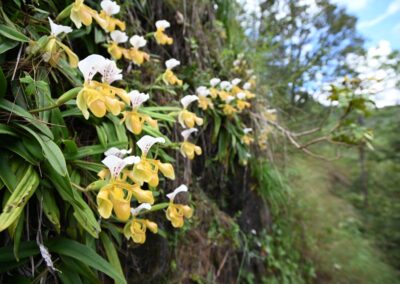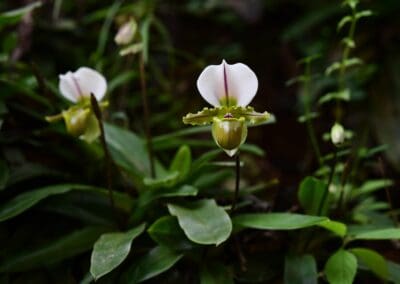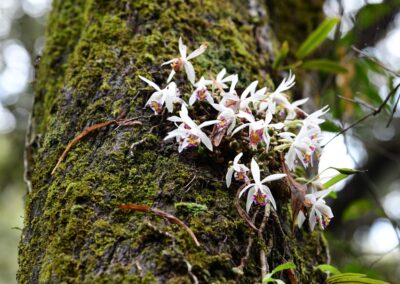Orchids of Yunnan
This botanical study tour through South and Southeast Yunnan offers a remarkable opportunity to explore the rich and diverse plant life of the region. This area is home to a variety of unique and captivating orchid species, including species of the genera Bulbophyllum, Holcoglossum, Paphiopedilum, Pleione and Vanda.
The species that flower in this area are rarely observed, and this is the first time that we have organized a tour that has a focus on Paphiopedilum. We expect to see 3 strikingly beautiful species in on our tour: Paphiopedilum dianthum, P. gratrixanum, and P. spicerianum. In addition, we will see Bulbophyllum rothschildianum, Holcoglossum kimballianum, Pleione maculata, and Vanda coerulea.
Dates & Prices
- Dates: October 1-15, 2024
- Price: $5200 per person (double accommodation)
- Single Room Supplement: $800 (total $5400)
- Date for Deposit: May 15, 2024
- Final payments due: June 1, 2024
- Price includes: Price includes ground transportation, drivers, guides, meals, hotel accommodations, entry to parks and reserves
- Not included: Round trip airfare, entry visas, travel insurance, alcholic beverages, personal items, tips.
- Currency: Currency exchange is best completed at the airport. In remote locations, only some certain banks can do currency exchange, but takes much time. Some ATMs are possible to draw out Chinese Yuan, with cards that have visa, and master card
- Leaders: Wenqing Perner and Hong Jiang
- Group Size: Minimum of 8 and a maximum of 11 (plus the 2 tour leaders and the OCA representative)
October 1. Visitors arrive in Kunming. Overnight in Kunming. Those wanting to arrive a day early can make arrangements to do so. If arriving early in the day and desiring a city tour (not included) arrangements can be made with our tour operator.
October 2. Visit to the Yunnan Academy of Forestry and Grassland Sciences. Tour greenhouse. Visit orchid germplasm bank in the morning, drive to Pingbian County in the afternoon. The Yunnan Academy of Forestry and Grassland Sciences is a comprehensive applied research institution of significance in the fields of forestry and grassland in Yunnan Province. The academy is committed to conducting investigations, research, technology dissemination, scientific and technological outreach, training, as well as domestic and international academic exchanges and scientific cooperation related to key scientific and technological aspects of forestry and grassland.
October 3. Observe Paphiopedilum dianthum and other orchids in the reserve. Overnight in Pingbian.
October 4. Pingbian-Hekou. Observe diverse orchids in limestone area. Limestone formations provide unique ecological niches that are favorable for various plant species, including orchids. Orchids, being adaptable and often epiphytic in nature, can find suitable habitats within the crevices, rock formations, and trees of limestone terrain. Paphiopedilum malipoense and Dendrobium hekouensis occur in this area. .
Overnight in Hekou.
October 5. Hekou-Zhenyuan. Observe Paphiopedilum wenshanense, other orchids. Overnight in Zhengyuan.
October 6. Zhengyuan-Jinggu. Observe Papiopedilum gratixianum, other orchids. Overnight in Jinggu.
October 7. Jingku-Simao. Observe Bulbophyllum rothschildianum, Pleione maculate. Overnight in Simao.
October 8. Simao. Visit Simao Laiyanghe Nature Reserve. Overnight in Simao. Simao is famous for its Pu’er Tea. The Caiyang River Nature Reserve in Simao is situated in an intermediate position connecting the southern tropical and central subtropical regions of Yunnan. It holds significant importance in terms of vegetation geography and biogeography. Among the dominant families in the plant flora in the reserve, there are Orchidaceae (223 species in 69 genera), Rubiaceae (100 species in 37 genera), Asteraceae (86 species in 47 genera), Fabaceae (82 species in 33 genera), Lamiaceae (62 species in 28 genera), Euphorbiaceae (59 species in 25 genera), Urticaceae (52 species in 13 genera), Poaceae (47 species in 34 genera), Lauraceae (44 species in 12 genera), Moraceae (44 species in 6 genera), and Verbenaceae (36 species in 26 genera).
October 9. Simoa-Menglian. Observe Paphiopedilum spicerianum and Paphiopedilum bellatulum. Overnight in Menglian.
October 10. Menglian-Lancang. Observe Renanthera imschootiana. Overnight in Lancang.
October 11. Linghong Ji’nou Mountain. Observe Vanda coerulea and other orchids in limestone mountain area. Overnight in Jinghong.
October 12. Mengla Menglun-Xishuanbania Tropical Botanical Gardens. Xishuangbanna Tropical Botanical Gardens is the largest botanical garden in China. The garden includes a 250-hectare region of well-preserved primary tropical rainforest, with excellent preservation of over 13,000 species of plants The focus for our trip will be the Shade Plant Garden dedicated to the collection and exhibition of foliage, flowering, terrestrial, and epiphytic plants. The garden primarily collects and displays around 600 species/varieties of plants, including tropical orchids, plants of the Bromeliaceae family as well as distinctive ferns, plants from the ginger family, Araceae, and Gesneriaceae.
Overnight at hotel in the Garden.
October 13. Drive from Jinghong to Kunming. Farewell dinner. Overnight in Kunming.
October 14. Visitors return home from Kunming.
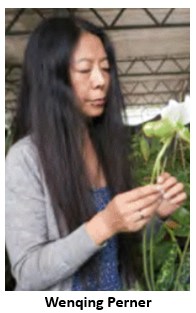 Wenqing Perner
Wenqing Perner
Wenqing and her late husband Holger Perner have led innumerable botanizing trips throughout China over the last 20 years. Wenqing is not only a superb tour organizer and orchid expert, she is also fluent in Mandarin, Japanese, English and German! Wenqing lives in Chengdu.
 Hong Jian, Ph.D.
Hong Jian, Ph.D.
Hong is a professor at the Forestry Institute in Kunming, and a co-author and the photographer for the stunning book “The Wild Orchids of Yunnan.” He is probably the foremost expert on the orchids of this province; needless to say, he knows where the orchids are! Hong lives in Kunming.
 Mary Gerritsen, Ph.D.
Mary Gerritsen, Ph.D.
Mary is the president of the Orchid Conservation Alliance. This will be her eighth botanic tour to China, and her fourth tour to Yunnan. Mary lives in San Mateo, CA.
This botanical study tour through South and Southeast Yunnan offers a remarkable opportunity to explore the rich and diverse plant life of the region. This area is home to a variety of unique and captivating orchid species, including specids of the genera Bulbophyllum, Holcoglossum, Paphiopedilum, Pleione and Vanda.
The species that flower in the are rarely observed, and this is the first time that we have organized a tour that has a focus on Paphiopedilum, We expect to see 3 striking beautiful species in on our tour: Paphiopedilum dianthum, P. gratrixanum, and P. spicerianum, In addition, we will see and Bulbophyllum rothschildianum, Holcoglossum kimballianum, Pleione maculata, and Vanda coerulea.
- Bulbophyllum rothschildianum: This impressive orchid species is known for its large, intricate flowers. The study tour provides an opportunity to witness its striking beauty and study its ecological preferences.
- Holcoglossum kimballianum: This epiphytic orchid is celebrated for its elegant, pendulous large pink and white flowers. Observing it in its natural habitat allows for a deeper understanding of its growth patterns and adaptation strategies.
- Paphiopedilum dianthum: this long twisted petals slipper orchid is a true marvel. Exploring its habitat helps researchers grasp its interactions with the environment and potential pollinators.
4.*Paphiopedilum gratrixianum and Paphiopedilum spicerianum: These slipper orchids are known for their unique shapes and captivating colors. A study tour enables participants to examine the specific conditions under which they thrive.
- Pleione maculate: This terrestrial orchid species features delicate, colorful flowers. The tour offers insights into its growth habits and the ecosystems it calls home.
- Vanda coerulea: This stunning blue orchid is native to the region and holds special significance. Observing it in its natural habitat is an opportunity to explore its interactions with other organisms and its role in the ecosystem.
Another interesting plant that we will see is Parashorea chinensis, the tallest tree in China (40-80m), and a distinctive plant of the tropical rainforest. This species is endemic to China.
Throughout the botanical study tour, participants will engage in various activities, including guided hikes, interactive workshops, and informative lectures led by expert botanists and ecologists. These activities may focus on the unique adaptations of these orchid species, their pollination mechanisms, habitat conservation, and the broader biodiversity of the Yunnan region.
Embarking on a botanical study tour in South and Southeast Yunnan also promises a multifaceted journey, encompassing not only the captivating plant life but also the rich landscapes, diverse ethnic cultures, and delightful cuisine of the region.
Landscapes
The tour takes participants through a breathtaking array of landscapes, from lush subtropical forests to rolling hills and highland plateaus. As you traverse the region, you’ll encounter pristine river valleys, serene lakes, and mist-covered mountains. The diverse topography plays a crucial role in nurturing a wide range of plant species, making the area a botanical paradise.
Ethnic Culture
South and Southeast Yunnan are renowned for their ethnic diversity, home to numerous indigenous communities each with its traditions and way of life. Some of the better known communities include the Miao Yao, Yi, Hani, Zhuang and Dai cultures, with their distinctive cuisines, attire and writing.
Food
The culinary journey during the study tour is an adventure in itself. Yunnan cuisine is celebrated for its unique blend of flavors and ingredients drawn from the region’s diverse landscapes. From spicy dishes to delicate herbal infusions, you’ll savor a variety of taste sensations. Local markets and eateries provide opportunities to indulge in dishes prepared using indigenous plants, some of which you may have encountered during your botanical explorations.
Throughout the tour, expert guides and local botanists will lead educational sessions, sharing their knowledge about the endemic flora, plant adaptations, and conservation efforts in the region.
